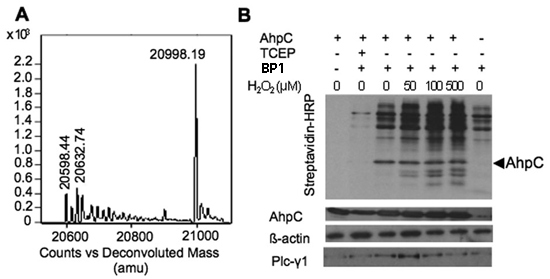Biotin-1,3-cyclopentanedione (BP1)
Biotin-1,3-cyclopentanedione (BP1) is a non-dimedone based probe and contains a biotin tag making it compatible with several techniques and forms of analysis. At physiological pH its reactivity is comparable with dimedone and has increasing activity at lower pH.
Features:
- Stable, reproducible binding to cysteine sulfenic acid (-SOH) at physiological pH; increased reactivity under acidic conditions
- Non-hydrolyzable amide linkage prevents cleavage
- Great for in vitro and in vivo applications
- Compatible with WB, ELISA, and Affinity Isolation
Redox-sensitive cysteine residues in proteins may serve as important components of oxidative signaling or sensors of oxidative stress. Cysteine sulfenic acid modification is an emerging area of interest for those studying biological signal transduction within the
From the laboratory of Cristina M. Furdui, PhD, Wake Forest School of Medicine.
Biotin-1,3-cyclopentanedione (BP1) is a non-dimedone based probe and contains a biotin tag making it compatible with several techniques and forms of analysis. At physiological pH its reactivity is comparable with dimedone and has increasing activity at lower pH.
Features:
- Stable, reproducible binding to cysteine sulfenic acid (-SOH) at physiological pH; increased reactivity under acidic conditions
- Non-hydrolyzable amide linkage prevents cleavage
- Great for in vitro and in vivo applications
- Compatible with WB, ELISA, and Affinity Isolation
Redox-sensitive cysteine residues in proteins may serve as important components of oxidative signaling or sensors of oxidative stress. Cysteine sulfenic acid modification is an emerging area of interest for those studying biological signal transduction within the
From the laboratory of Cristina M. Furdui, PhD, Wake Forest School of Medicine.
| Catalog Number | Product | DataSheet | Size | AVAILABILITY | Price | Qty |
|---|
| End Date: | 10/18/2023 |
| Product Type: | Small Molecule |
| Name: | Biotin-1,3-cyclopentanedione (BP1) |
| Chemical Formula: | C17H25N3O4S2 |
| Molecular Weight: | 399.5281 |
| Format: | light yellow solid |
| Purity: | > 90% by NMR |
| Solubility: | The producing laboratory recommends using 100% DMSO to make a 100mM stock. Once dissolved, it can be aliquotted and stored at -20C to -80C for further experiments. It is recommended to avoid multiple freeze-thaw cycles. It is recommended to wait to dissolve in aqueous buffer to (typically 1 mM) until right before using in experiments. |
| Stability: | > 6 months at -20C |
| Storage: | Store at -20C. Avoid multiple freeze-thaw cycles |
| Shipped: | Cold packs |

Reaction products of pure protein and cell lysates with BP1. (A) ESI-TOF MS spectrum showing C165S AhpC-BP1 covalent adduct formation. (B) Western-blot analysis of proteins from NIH 3T3 cell lysates labeled with BP1. The blot was probed with streptavidin-HRP, and antibodies for AhpC and beta-actin. Samples after enrichment in proteins labeled with BP1 were probed for PLCγ1.
Adapted from: Qian, J., et al. Chem. Commun., 47, 92039205 (2011).
- Qian, J., Klomsiri, C., Wright, M.W., King, S.B., Tsang, A.W., Poole, L.B, and Furdui, C.M. Simple synthesis of 1,3-cyclopentanedione derived probes for labeling sulfenic acid proteins. Chem. Commun., 47, 9203-9205 (2011).
- Bansal N, Mims J, Kuremsky JG, Olex AL, Zhao W, Yin L, Wani R, Qian J, Center B, Marrs GS, Porosnicu M, Fetrow JS, Tsang AW, Furdui CM. Broad phenotypic changes associated with gain of radiation resistance in head and neck squamous cell cancer. Antioxid Redox Signal. 2014 Jul 10;21(2):221-36. View Article
- McAdam E, Brem R, Karran P. Oxidative Stress-Induced Protein Damage Inhibits DNA Repair and Determines Mutation Risk and Therapeutic Efficacy. Mol Cancer Res. 2016 Jul;14(7):612-22. doi: 10.1158/1541-7786.MCR-16-0053. PubMed PMID: 27106867; PubMed Central PMCID: PMC4955916. View Article
- Dotsey EY, Jung KM, Basit A, Wei D, Daglian J, Vacondio F, Armirotti A, Mor M, Piomelli D. Peroxide-Dependent MGL Sulfenylation Regulates 2-AG-Mediated Endocannabinoid Signaling in Brain Neurons. Chem Biol. 2015 May 21;22(5):619-28. doi: 10.1016/j.chembiol.2015.04.013. PubMed PMID: 26000748; PubMed Central PMCID: PMC4459529. View Article
- Guven M, Brem R, Macpherson P, Peacock M, Karran P. Oxidative Damage to RPA Limits the Nucleotide Excision Repair Capacity of Human Cells. J Invest Dermatol. 2015 Nov;135(11):2834-2841. View Article
- Long D, Wu H, Tsang AW, Poole LB, Yoza BK, Wang X, Vachharajani V, Furdui CM, McCall CE. The Oxidative State of Cysteine Thiol 144 Regulates the SIRT6 Glucose Homeostat. Sci Rep. 2017 Sep 8;7(1):11005. View Article
- Alvarado G, Tóth A, Csősz É, Kalló G, Dankó K, Csernátony Z, Smith A, Gram M, Akerström B, Édes I, Balla G, Papp Z, Balla J. Heme-Induced Oxidation of Cysteine Groups of Myofilament Proteins Leads to Contractile Dysfunction of Permeabilized Human Skeletal Muscle Fibres. Int J Mol Sci. 2020 Oct 31;21(21):8172. View article
If you publish research with this product, please let us know so we can cite your paper.


